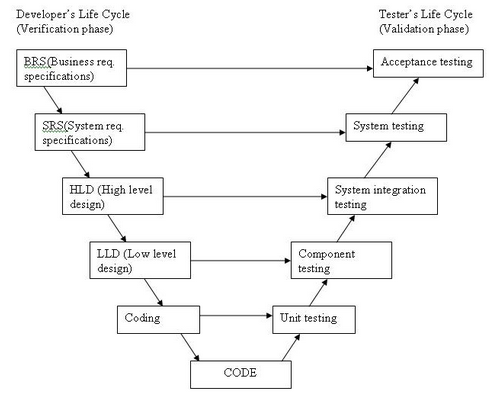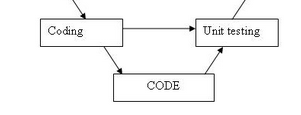Introduction to software development life cycle (SDLC)
Chapters
V-Model
V-model is SDLC model where process execution takes place in a sequential order in V-shape hence it named as v-model. It is same as waterfall model where each phase must complete and its output will be the input for next phase. In this model testing team will involve at the stage of requirement only. Testing of the product is planned along with a corresponding development phase. V-model is also known as Verification and Validation model.
V-model Diagram:

Requirements:
BRS (Business Requirement Specifications) / CRS (Customer Requirement Specification) this document is prepared by business analyst / product analyst and SRS (System Requirement Specification) is prepared by project manager or team lead.

At this stage development and testing team will review the CRS for any missing requirement and prepare the required test document, they are User Accepting Test plan and User Accepting Test case document.

At this stage they will review the SRS and prepare the required test document, they are System Test plan and System Test case document.

At this stage they will review the HLD and prepare the required test document, they are System Integration Test plan and System Integration Test case document.

At this stage they will review the LLD and prepare the required test document, they are Component Test plan and Component Test case document.

At this stage developers starts coding and before handover application to testing team they will do one round of testing is known as unit testing.
Unit testing / Whitebox testing / Glassbox testing/ Openbox testing:
This testing is done by the developers before handover the application to the testing team they check each and every line of code written by them.
Component testing / Functional testing:
Testing each and every components of module independently is called functional testing.
System Integration Testing:
Testing the data flow/interface between the modules is known as system integration testing.
System testing:
checking the end to end flow of an application i.e. navigate through all the modules and check, if the application is working as a whole or not.
User Acceptance Testing (UAT):
It is a testing done by the customer before accepting the product.
The high-level design (HLD): It is a blue print of the application,
it provide overview of solution, system, platform and process. It contains modules in the form of flow diagram.
The low-level design (LLD):
It is also blue print where it provides detail description of flow diagram which has modules with its components also.
The implementation:
In this phase, coding takes place. After completion of coding, the path of execution continues up the right side of the V where the test plans developed at the beginning are come to use now.
Coding:
this is the phase where developers convert module design into code.
When to use the V-model:
- Whenever the project is small to medium sized and with clearly defined requirements.
- We use v-model in the case of complex project.
Advantages of V-model:
- In this module testing activities begins at very early stage i.e. at the stage of requirement. Hence time consumption is less and also higher chance of success.
- Simple and easy to use.
- Requirement review is exist hence there is no the downward flow of the defects.
- Parallel deliverables are exists i.e. review and testing
- Test documents can be re-used
- Requirement changes are allowed
- Due to review process that is defects are found at early stage.
Disadvantages of V-model:
- It is costlier
- Lots of re-work will be there, if customer ask for changes
- If any modification is needed in midway, then the test documents and requirement documents has to be updated.
- It is not much flexible for changes
In next chapter we will explore the iterative model
Description
This tutorial covers
- What is SDLC
- Waterfall Model
- Spiral Model
- Prototype Model
- V-Model
- Iterative model
- Big Bang Model
- RAD Model
- Agile Model
- Useful resources to futher your understanding on SDLC
Report any errata directly using our support forms
Audience
Beginners looking to get their hands on understanding of software development life cycle (SDLC)
Learning Objectives
A quick introduction to SDLC
Author: Subject Coach
Added on: 30th Jul 2015
You must be logged in as Student to ask a Question.
None just yet!